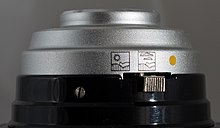Agfa Click
Agfa Click the name of the last Agfa - roll film camera in the format 6 x 6 cm with 120 roll film .
The Click was the last roll film camera in the series, from the Rietzschel predecessors to the Standards, the Billys , the Boxes and Records to the Isolettes . The floor cameras turned into folding cameras , boxes and finally those with a fixed tube. The Clack camera formed an intermediate form from the box to the click. There were not only changes in the technical structure. Wood, metal and leather were replaced by plastic at the Click. Only a few mechanical parts were made of metal.
Distinguishing features
The viewfinder either has a straight base (viewfinder 1) or is canted (viewfinder 2).
surface
Clasp
Single shutter with only one exposure time, no B setting, no cable release connection possible.
cover
Made in ...
Locking mechanism
a) can be seen from the front through the front lens b) is covered (on 1292 and 1310)
Lightning connection
The Clibo speed camera is required for the Agfa Click with its special flash connection. It can also be used with the Synchro-Box (Cli = Click, bo = Box).
In India, Agfa offered a specially manufactured flash with a Clibo base: Agfa A-1.
Film stage
The film stage is curved. This improves the outline of the simple lenses (as with the Isoly cameras).
Back wall
The back wall is held in place by 2 springs and is completely removable.
Weights
The weights are different. There are two areas: around 175 grams, around 265 grams. It seems that Agfa built weights into some models to make the camera heavier and therefore more valuable. Until then, cameras were mostly made of metal. The almost complete use of plastic resulted in a significant reduction in weight. The 185 grams of the Click IV are explained by the metal accessory shoe.
equipment
- Plastic bag light brown with beige border on top, Agfa number 6047, "1-59" under the flap
- Brown plastic bag with a dark brown border on top, Agfa number 6047
- Brown leather bag, no number, top part with 2 rivets, probably Made in France
- Brown leather bag, no number, upper part 4 rivets, probably made in India
- Black leather bag, no number, upper part 4 rivets, probably Made in India
- Plastic bag ocher, without number, leather grain, probably Made in India
- Cliboblitz, Agfa number 6864
- Cliboblitz, Agfa number 6865, without plastic bag, blue in the original packaging
- Cliboblitz, Agfa number 6865, with plastic bag, red packaging
- Plastic bag for the Cliboblitz, Agfa number 6074
- A-1 Flash Gun, Made in India
- Sun visor, plug connector, 30mm, Agfa numbers 6300 and 6310
- Auxiliary lens 1–2m, for close-ups, Agfa number 9574
- Auxiliary lens 1–2.5m, for portraits, plug connection, 30mm, Agfa numbers 6701 and 6702
- Yellow filter, plug connection, 30mm, Agfa number 9110
Model overview
The Kadlubek number refers to KADLUBEKS CAMERA CATALOG, 5th expanded and updated edition 2004; in some variations "V" and "W" were added.
By Günther Kadlubek and Rudolf Hillebrand from the PhotoDeal edition
| Surname | Agfa_number | Kadlubek number | year | lens | Viewfinder | surface | Aperture / filter | Made in ... | Locking mechanism | Weight | Illustration |
|---|---|---|---|---|---|---|---|---|---|---|---|
| Click I | 0641/100 | AGF1290 | 1958 | Meniscus 72.5mm / 11.0 | perpendicular | horizontal stripes | Yellow filter | Germany under front lens | visible | 175 g | |
| Click I | dto | AGF1291 | 1958 | Meniscus 72.5mm / 11.0 | cantilevered | grained | Yellow filter | France to tripod thread | visible | 269 g |
|
| Click I | dto | AGF1292 | 1958 | Meniscus 72.5mm / 11.0 | perpendicular | horizontal stripes | Yellow filter | Germany under front lens | covered | 176 g |
|
| Click I | dto | AGF1293 | 1958 | Meniscus 72.5mm / 11.0 | cantilevered | horizontal stripes | Yellow filter | Germany under front lens | visible | 175 g |
|
| Click II | 0642/000 | AGF1300 | 1959 | Achromat 72.5mm / 8.8 | perpendicular | leather black | Portrait lens | Germany on the front ring | visible | 178 g | |
| Click II | dto | AGF1300V | 1959 | Achromat 72.5mm / 8.8 | perpendicular | leather black | Portrait lens | no MiGermany | visible | 178 g | |
| Click II | dto | AGF1301 | 1959 | Achromat 72.5mm / 8.8 | cantilevered | leather black | Portrait lens | Germany on the front ring | visible | 263 g | |
| Click II | dto | AGF1301V | 1959 | Achromat 72.5mm / 8.8 | cantilevered | leather black | Portr lens + yellow filter | Germany on the front ring | visible | 265 g | |
| Click II | dto | AGF1301W | 1959 | Achromat 72.5mm / 8.8 | cantilevered | Leather gray | Portr lens + yellow filter | Germany on the front ring | visible | 264 g | |
| Click III | 0643/000 | AGF1310 | 1959 | Achromat 72.5mm / 8.8 | cantilevered | grained | Yellow filter | India - glue | covered | 173 g | |
| Click IV | 0644/000 | AGF1320 | 1960 | Achromat 72.5mm / 8.8 | cantilevered | horizontal stripes | 3 apertures | India | visible | 185 g |
Web links
Individual evidence
- ^ Günther Kadlubek and Rudolf Hillebrand: Kadlubek's camera catalog . 5th expanded and updated edition. Verlag Rudolf Hillebrand, Neuss 2004, p. 984 .





























